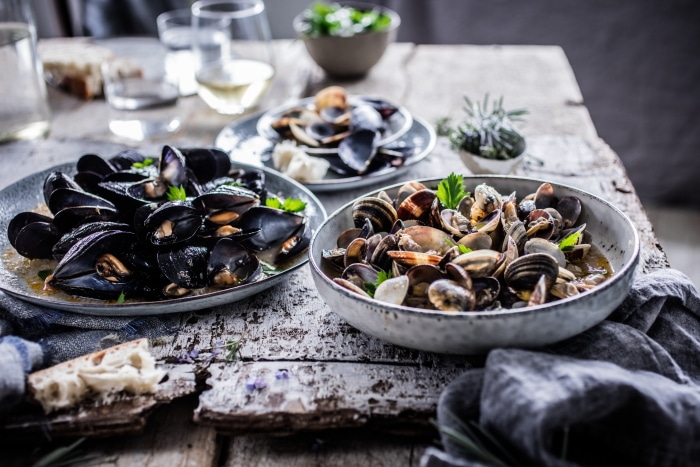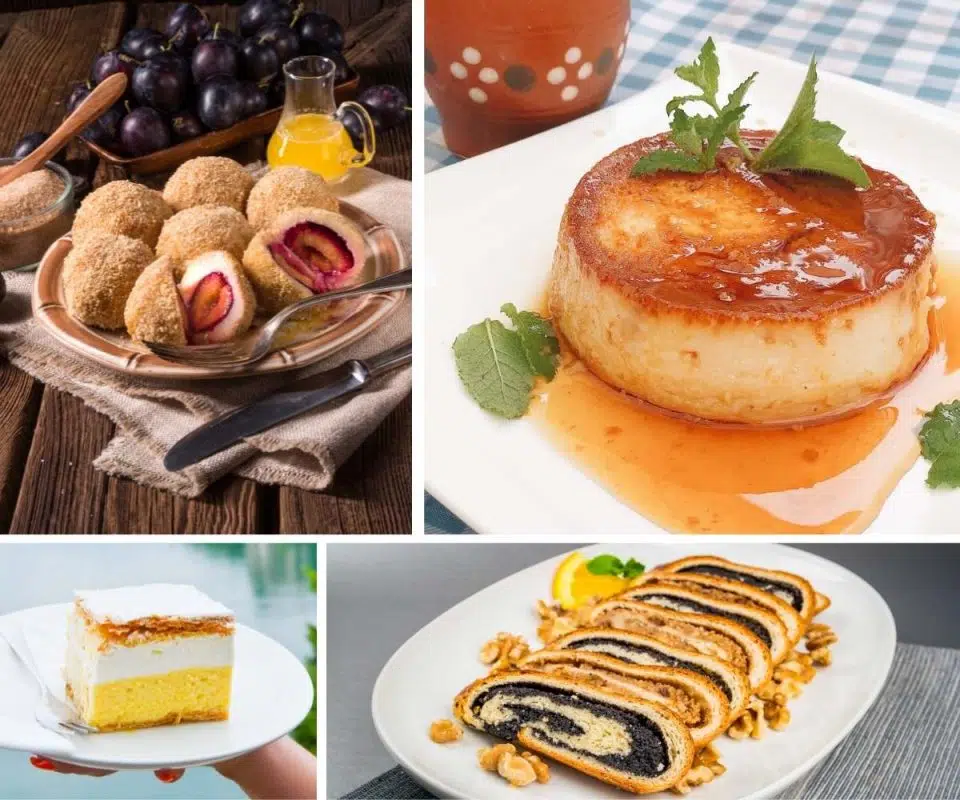A Foodie’s Bucket List: Exploring Croatian Cuisine

Croatia is a small, but also very diverse country that has been influenced by many different types of cultures over the centuries, leaving a varied and amazingly rich variety of food, wine, and other gastronomical delights.
Although the country is broken down into 21 government municipalities, the country essentially consists of two main geographic areas, continental and coastal. But as each local area is very specific and has its own specialties, we’ll take you through 10 different sub-regions and let you decide what your palate fancies.
Related: 12 Most Popular Croatian Foods
Zagreb
The Croatian capital of Zagreb is young and playful at heart, despite the almost thousand-year-old history of its old town. The city has a thriving restaurant scene, from old traditional family-run restaurants to modern Michelin-star cuisine. Zagreb is surrounded by lush countryside that has been feeding the city for centuries, supplying it with excellent natural and fresh ingredients.
Being only a couple of hours away from the Adriatic Coast, Zagreb also offers an extensive seafood selection and is home to one of the most famous open-air food markets – Dolac.


Central Croatia
Not far from the capital, Central Croatia is the area north and east of Zagreb, lying in the valleys of the rivers Sava, Drava, and Mura. It is known for the ‘continental character’ of the country and features some of Croatia’s most beautiful rural scenery.
The region’s lowlands are complemented by mellow hills and slopes, mostly covered with vineyards, oak forests, rivers, and beech and other deciduous trees.
The region is known for things like štrukli (cheese filled cooked or baked dough) and meals such as purica (turkey) and mlinci (a side dish – thin dried flatbread torn into smaller pieces and submerged in hot water to soften).

Slavonia
The region of Slavonia (‘Slavonija’ in Croatian) is the lesser-known, far eastern part of Croatia. It is shaped by the force of the mighty Drava, Danube, and Sava rivers and is characterized by a distinctive, captivating rural landscape.
It features the wide, endless expanse of the golden Pannonia agricultural plains, and the hills peppered with vineyards produce some of the best wines in Croatia.
The culturally diverse mix here is reflected in Slavonia’s regional cuisine, with Hungarian, Viennese, and Central European recipes influencing local dishes. Slavonia is also an excellent wine region and claims to be home to the world’s largest wine barrel, in Erdut, and some of the most beautiful wine cellars in the Ilok area.



Lika & Karlovac
The Lika and Karlovac regions are located in central Croatia and act as a link between the continental and coastal parts of the country, connecting Central Europe to the Adriatic Sea. The area is known for its natural beauty, including lush green landscapes, majestic mountains, sparkling clear springs and a high concentration of protected Nature Parks.
Both areas are well-known for fresh water fishing along their river banks and amazing landscapes for all outdoor activities – a great place to try some fresh-water trout and golden Lika potatoes, seasoned with local organic herbs.



Kvarner
Flanked by majestic mountains, Kvarner is a year-round destination offering an inimitable combination of sea, islands, and highlands.
You can enjoy the sea breeze as you yacht, swim in cobalt blue waters, and then take refuge from the heat in the nearby woods in the hinterland.
The region is home to some of the best seafood in the country, including scampi, with an amazing fish market in Rijeka, with Michelin-star cuisine available to the discerning visitor.


Gorski Kotar
Moving inland you come to the mountainous Gorski Kotar region, often called the ‘green lungs of Croatia,’ as over 60% of its land is forest.
The region offers an exceptional array of cycling, hiking, and other outdoor options, while providing sanctuary to an abundance of wildlife and some of the most diverse edible wild produce.
Istria
Northwest of Kvarner, Istria is the most western region of Croatia and the Adriatic Sea’s largest peninsula, its heart-shaped form reaching deep into crystal-clear waters. Blue seas, white stone and the green interior make up the color scheme of the region.
The unspoiled Istrian inland abounds with rolling hills and valleys, hilltop villages, wheat fields, vineyards, and olive groves; while picturesque medieval towns, clean shores and ports, lively fishing villages, and teeming narrow stone streets radiate a special Mediterranean charm. Home to some of the world’s best truffles and award-winning olive oil and amazing wines, the area is a gastronomic delight.


Dalmatia
Further south, after leaving Istria and passing Kvarner’s coast, the longest expanse along the eastern coast of the Adriatic Sea is Dalmatia, mostly characterised as a coastal region with its coves, secluded beaches, islands, and inlets. Known for its warm sea, picturesque landscape, rich history, and beautiful islands, it makes a perfect destination for both outdoor activities and cultural trips.
Dalmatia consists of four areas: Zadar, Šibenik, Split, and Dubrovnik. Each is home to some of the world’s most famous UNESCO sites, acting as the backdrop to numerous film sets, providing the best sailing has to offer, and some of the most interesting cuisine in Croatia.

Zadar
The islands, coastline, and hinterland of the Zadar region offer everything that today makes Mediterranean cuisine the most popular in the world. Here you will find bare, sun-exposed rocky regions where, aside from offering everything active tourism enthusiasts desire, you’ll find the sturdiest therapeutic plants of the Kornati archipelago, local sheep, goats, donkeys, wild game, and bees, and a very specific taste and texture to all local cuisine.
The most fertile agricultural area of Ravni Kotari offers some of the most sought-after fruit and vegetables, and, aside from some of the best hiking, cycling and kayaking, this area boasts some of the best cherries in the world, the famous Marasca cherries, which go into the world-renowned Maraschino liqueur. The region is also home to some of the best cheese in the world, Paški sir.


Šibenik
The landscape of the Šibenik region is known as a unique natural monuments and where man has created grade ‘A’ cultural monuments topping the world’s list of heritage, such as Šibenik’s cathedral, and the brilliant work of Juraj Dalmatinac (Giorgio da Sebenico).
This region, spreading from the canyon, waterfalls, and mouth of the River Krka to the Kornati archipelago, is an area of the most beautiful and most carefully preserved national parks of Croatia.
The gastronomy of this region is equally impressive. It combines some of the oldest achievements not only of this region but of the human diet in general with dishes that are part of the most sought-after menus of the luxurious restaurants of the world. It is here that “mišni sir”, a cheese made from milk naturally curdled in a sheep’s skin bag, and wild oysters are still enjoyed today in the same way they were thousands of years ago.



Split
The Split region protects the coastal areas below with both Mosor and Biokovo offering an escape for the true adventurist from the sun and sea that may be found along the coast. The islands of Brač, Šolta, Čiovo, as well as the farther island of Vis and the sunniest island of Hvar can all easily be accessed by ferry from Split.
The city itself boasts an impressive history, spanning over 1,700 years when Diocletian’s palace was erected, and is now home to some of the most interesting little bistros and wine bars for every tourist’s palate. In this region the principles of so-called Dalmatian minimalism are consistently respected by using the best ingredients, including the most prized local fish, dory, dentex, bream or mullet, roasted or fried in the quickest and simplest way to preserve their perfect natural flavours.
Endless variations of traditional recipes are also available, some of which require complex seasoned compositions prepared over several days, such as “pašticada” beef stew. After a coffee on any of the rivas dotting the coastline, find the time to explore the region, whether by car, bike or boat – the vistas are amazing.

Dubrovnik
Although the walled-city of Dubrovnik is now instantly recognized as Game of Thrones’ King’s Landing, it has been for years been known as the Pearl of the Adriatic. It is surrounded by some of the best wine regions and by islands such as Mljet and Korčula, as well as the Elaphiti Islands.
Whether you are looking for haute cuisine, a glass of Dingač – a wine made from Plavac Mali and genetically tied to Zinfandel, or would prefer to walk the walls of this amazing UNESCO heritage site, you will definitely want to come back.
Culinary multiculturalism has been active in Dubrovnik for centuries. Contemporary hospitality of this region maintains this unique tradition with a whole range of dining offers, from rural cuisine prepared over an open-fire and the grilled food of the Konavle villages to the most luxurious Adriatic restaurants with magnificent views of the city walls.

Story and visuals put together with the help of the Croatian National Tourist Board.
Related: Most Popular Croatian Desserts


